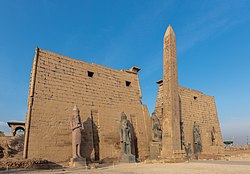
Back معبد الأقصر Arabic معبد الاقصر ARZ Templu de Lúxor AST Луксорскі храм Byelorussian Храм в Луксор Bulgarian লাক্সর মন্দির Bengali/Bangla Temple de Luxor Catalan Luxorský chrám Czech Luxor-Tempel German Ναός του Λούξορ Greek
 Entrance of the temple (first pylon) | |
| Location | Luxor, Luxor Governorate, Egypt |
|---|---|
| Region | Upper Egypt |
| Coordinates | 25°42′0″N 32°38′21″E / 25.70000°N 32.63917°E |
| Type | Sanctuary |
| Part of | Thebes |
| History | |
| Founded | 1400 BCE |
| Site notes | |
| Official name | Temple of Luxor |
| Part of | Ancient Thebes with its Necropolis |
| Criteria | Cultural: (i), (iii), (vi) |
| Reference | 87-002 |
| Inscription | 1979 (3rd Session) |
| Area | 7,390.16 ha (28.5336 sq mi) |
| Buffer zone | 443.55 ha (1.7126 sq mi) |
The Luxor Temple (Arabic: معبد الأقصر) is a large Ancient Egyptian temple complex located on the east bank of the Nile River in the city today known as Luxor (ancient Thebes) and was constructed approximately 1400 BCE. In the Egyptian language it was known as ipet resyt, "the southern sanctuary". It was one of the two primary temples on the east bank, the other being Karnak.[1] Unlike the other temples in Thebes, Luxor temple is not dedicated to a cult god or a deified version of the pharaoh in death. Instead, Luxor temple is dedicated to the rejuvenation of kingship; it may have been where many of the pharaohs of Egypt were crowned in reality or conceptually (as in the case of Alexander the Great, who claimed he was crowned at Luxor but may never have traveled south of Memphis, near modern Cairo).
To the rear of the temple are chapels built by Amenhotep III of the 18th Dynasty, and Alexander. Other parts of the temple were built by Tutankhamun and Ramesses II. During the Roman era, the temple and its surroundings were a legionary fortress and the home of the Roman government in the area. During the Roman period a chapel inside the Luxor Temple originally dedicated to the goddess Mut was transformed into a Tetrarchy cult chapel and later into a church.[2]
Along with the other archeological sites in Thebes, the Luxor Temple was inscribed on the UNESCO World Heritage List in 1979.[3]
- ^ Science, "Excavation of the Temple of Luxor," Science, 6, no. 6 (1885): 370.
- ^ "Chapel of Imperial Cult". Madain Project. Retrieved 10 April 2019.
- ^ "Ancient Thebes with its Necropolis". UNESCO World Heritage Centre. United Nations Educational, Scientific, and Cultural Organization. Retrieved 7 September 2021.
